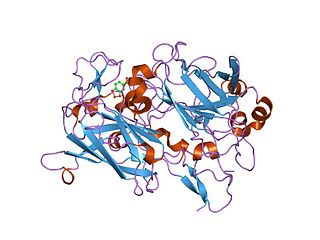Related Research Articles

Phosphoglycerate mutase (PGM) is any enzyme that catalyzes step 8 of glycolysis - the internal transfer of a phosphate group from C-3 to C-2 which results in the conversion of 3-phosphoglycerate (3PG) to 2-phosphoglycerate (2PG) through a 2,3-bisphosphoglycerate intermediate. These enzymes are categorized into the two distinct classes of either cofactor-dependent (dPGM) or cofactor-independent (iPGM). The dPGM enzyme is composed of approximately 250 amino acids and is found in all vertebrates as well as in some invertebrates, fungi, and bacteria. The iPGM class is found in all plants and algae as well as in some invertebrate, fungi, and Gram-positive bacteria. This class of PGM enzyme shares the same superfamily as alkaline phosphatase.

The transsulfuration pathway is a metabolic pathway involving the interconversion of cysteine and homocysteine through the intermediate cystathionine. Two transsulfurylation pathways are known: the forward and the reverse.
In enzymology, a pyrroloquinoline-quinone synthase (EC 1.3.3.11) is an enzyme that catalyzes the chemical reaction
Acireductone dioxygenase [iron(II)-requiring] (EC 1.13.11.54) is an enzyme that catalyzes the chemical reaction
Acireductone dioxygenase (Ni2+-requiring) (EC 1.13.11.53) is an enzyme that catalyzes the chemical reaction
In enzymology, a stizolobinate synthase (EC 1.13.11.30) is an enzyme that catalyzes the chemical reaction
In enzymology, a S-methyl-5-thioribose-1-phosphate isomerase is an enzyme that catalyzes the chemical reaction

The enzyme methylthioribulose 1-phosphate dehydratase (EC .2.1.109) catalyzes the chemical reaction
The enzyme propanediol dehydratase (EC 4.2.1.28) catalyzes the chemical reaction

In enzymology, a bisphosphoglycerate phosphatase (EC 3.1.3.13) is an enzyme that catalyzes the chemical reaction
The enzyme lipid-phosphate phosphatase (EC 3.1.3.76) catalyzes the reaction

Dioxygenases are oxidoreductase enzymes. Aerobic life, from simple single-celled bacteria species to complex eukaryotic organisms, has evolved to depend on the oxidizing power of dioxygen in various metabolic pathways. From energetic adenosine triphosphate (ATP) generation to xenobiotic degradation, the use of dioxygen as a biological oxidant is widespread and varied in the exact mechanism of its use. Enzymes employ many different schemes to use dioxygen, and this largely depends on the substrate and reaction at hand.
Bisphosphate may refer to:

Cobalamin biosynthesis is the process by which bacteria and archea make cobalamin, vitamin B12. Many steps are involved in converting aminolevulinic acid via uroporphyrinogen III and adenosylcobyric acid to the final forms in which it is used by enzymes in both the producing organisms and other species, including humans who acquire it through their diet.
7,8-didemethyl-8-hydroxy-5-deazariboflavin synthase (EC 4.3.1.32, FO synthase) and 5-amino-6-(D-ribitylamino)uracil—L-tyrosine 4-hydroxyphenyl transferase (EC 2.5.1.147) are two enzymes always complexed together to achieve synthesis of FO, a precursor to Coenzyme F420. Their systematic names are 5-amino-5-(4-hydroxybenzyl)-6-(D-ribitylimino)-5,6-dihydrouracil ammonia-lyase (7,8-didemethyl-8-hydroxy-5-deazariboflavin-forming) and 5-amino-6-(D-ribitylamino)uracil:L-tyrosine, 4-hydroxyphenyl transferase respectively. The enzymes catalyse the following chemical reactions:
2-hydroxy-3-keto-5-methylthiopentenyl-1-phosphate phosphatase (EC 3.1.3.87, HK-MTPenyl-1-P phosphatase, MtnX, YkrX) is an enzyme with systematic name 2-hydroxy-5-(methylthio)-3-oxopent-1-enyl phosphate phosphohydrolase. This enzyme catalyses the following chemical reaction
Carotenoid 1,2-hydratase (EC 4.2.1.131, CrtC) is an enzyme with systematic name lycopene hydro-lyase (1-hydroxy-1,2-dihydrolycopene-forming). This enzyme catalyses the following chemical reaction
Pyridoxal 5′-phosphate synthase (glutamine hydrolysing) (EC 4.3.3.6, PdxST) is an enzyme with systematic name D-ribose 5-phosphate,D-glyceraldehyde 3-phosphate pyridoxal 5′-phosphate-lyase. This enzyme catalyses the following chemical reaction
2,3-diketo-5-methylthiopentyl-1-phosphate enolase is an enzyme with systematic name 2,3-diketo-5-methylthiopentyl-1-phosphate keto-enol-isomerase. This enzyme catalyses the following chemical reaction
References
- ↑ Myers RW, Wray JW, Fish S, Abeles RH (November 1993). "Purification and characterization of an enzyme involved in oxidative carbon-carbon bond cleavage reactions in the methionine salvage pathway of Klebsiella pneumoniae". The Journal of Biological Chemistry. 268 (33): 24785–91. PMID 8227039.
- ↑ Wray JW, Abeles RH (February 1995). "The methionine salvage pathway in Klebsiella pneumoniae and rat liver. Identification and characterization of two novel dioxygenases". The Journal of Biological Chemistry. 270 (7): 3147–53. doi: 10.1074/jbc.270.7.3147 . PMID 7852397.
- ↑ Wang H, Pang H, Bartlam M, Rao Z (May 2005). "Crystal structure of human E1 enzyme and its complex with a substrate analog reveals the mechanism of its phosphatase/enolase activity". Journal of Molecular Biology. 348 (4): 917–26. doi:10.1016/j.jmb.2005.01.072. PMID 15843022.